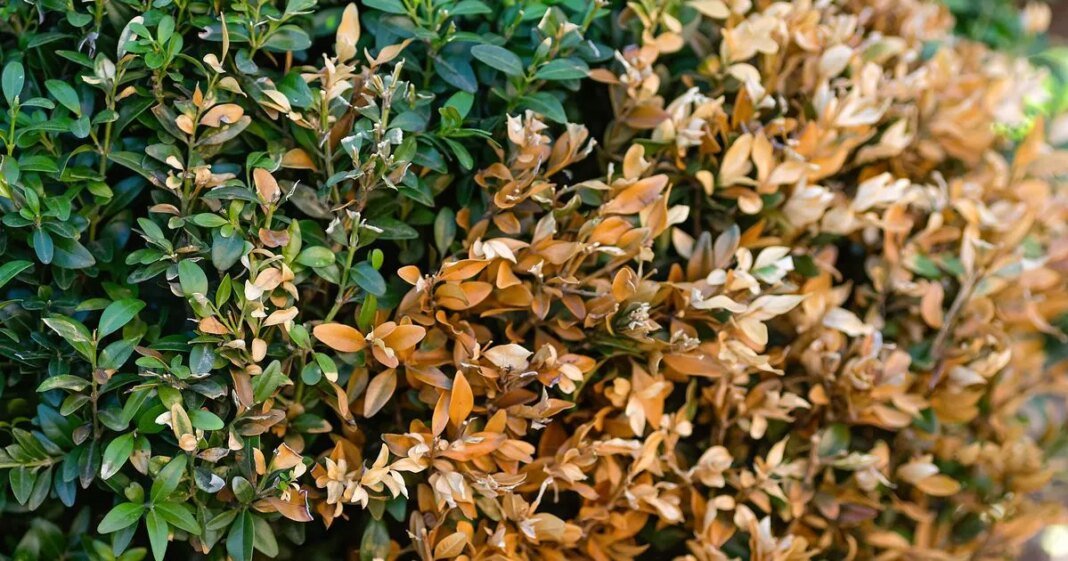Early autumn marks the ideal period for planting evergreen hedges like yew, box, holly, escallonia, or Portuguese laurel. However, it’s important to note that yew and box hedges grow at a slow pace. One reader shared concerns about their ten-year-old box hedges displaying browning in certain areas.
The browning seen on mature box hedges is a prevalent issue nowadays and can stem from various causes. One significant culprit is box blight, manifesting as brown patches on leaves, black streaks on stems, and leaf shedding. Another potential cause could be the box moth caterpillar, known for rapidly consuming leaves and leaving webbing traces. Browning may also result from drought stress or inadequate air circulation.
Given the age of your hedge, it holds value, so thorough inspection for caterpillars or black streaks on stems is advisable to determine the root cause. If caterpillars are the issue, regular monitoring and treatment can help control them. In cases of blight, pruning affected sections, enhancing airflow, and applying a box ‘feed and protect’ solution are recommended. While there’s no need for immediate panic, swift action to identify the problem is crucial for selecting the appropriate treatment.
Despite recent warm spells, the onset of autumn is imminent. Our climate often blurs the lines between seasons, allowing later-blooming perennials to bring lush greenery and vibrant hues to gardens, persisting until the initial frosts arrive.
September not only boasts scenic charm but also serves as an opportune time for planting herbaceous perennials, benefiting from the lingering warmth in the soil. Ensuring adequate watering during dry spells will aid in the plants’ establishment before daylight hours dwindle and colder temperatures set in.
Asters, often referred to as frost flowers for their ability to bloom until the first frost, derive their name from the Greek and Latin words signifying ‘star,’ reflecting the flowers’ distinctive shape. Legend has it that these flowers originated from the tears of the Greek goddess of purity, Astraea, shed upon witnessing the scarcity of stars in the sky.
Varieties like ‘Pink Parfait,’ a New England Aster with charming pink daisy-like blooms, exhibit some resistance to powdery mildew. Proper planting in moist, well-drained soil and cutting back stems post-flowering in late autumn are recommended practices.
Other options include ‘Winston Churchill,’ another mildew-resistant aster flaunting vivid carmine-pink flowers, and an array of Japanese anemones available for selection. These plants, like the classic pink-flowered variant and the elegant ‘Honorine Jobert’ white version, thrive in partial shade with moist soil conditions.
Rudbeckias, also known as coneflowers or Black-eyed Susans due to their dark central cones, illuminate September gardens with their bright yellow daisy blooms, thriving best under full sunlight. Leaving them to overwinter benefits birds as their seed heads offer both aesthetic appeal and a food source.
For a burst of sunshine hue, consider the perennial sunflower ‘Helianthus Soleil d’Or,’ sporting vibrant double yellow flowers that reach about three feet in height, perfect for enhancing container displays. Surrounding it with complementary filler and trailing plants like cosmos, calendula, and nasturtiums adds depth and color variation to arrangements.
To infuse delightful fragrance into your garden, incorporating phlox varieties like ‘Monica Lynden-Bell,’ boasting a vigorous growth habit and captivating scent, can attract bees and butterflies, sustaining a summery ambiance. The ‘Blue Lace Flower,’ an annual originating from Australia with sky blue dome-shaped blooms, offers a fragrant, bee-friendly option for cut flower arrangements, thriving best in full sunlight.
In conclusion, the transition into autumn presents ample opportunities for enriching gardens with a diverse array of plant species that thrive in the changing seasonal conditions, ensuring a vibrant and visually appealing outdoor space for enthusiasts to enjoy.



